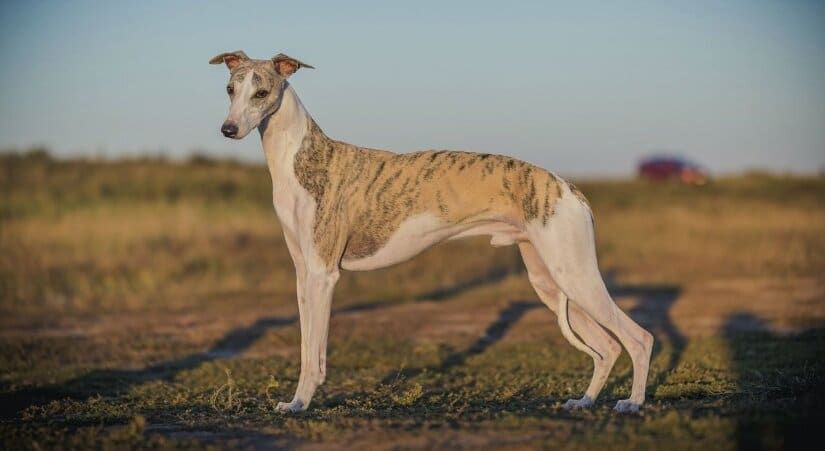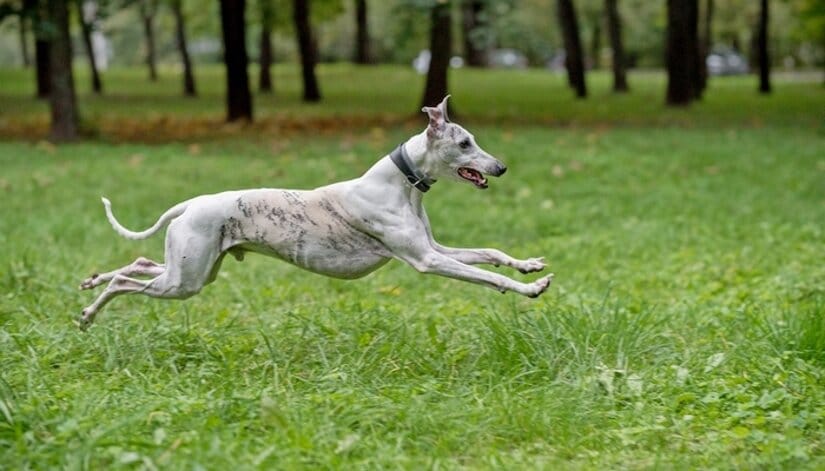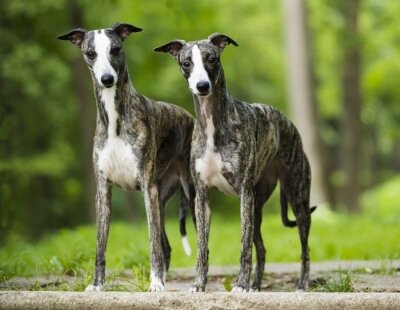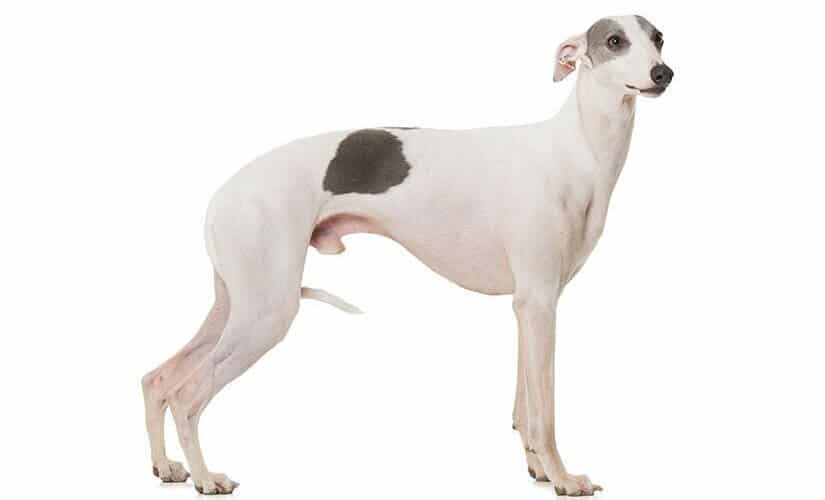
18-21 female



The Whippet originated from the U.K, and is part of the UKC, Sighthound Group, and the AKC, Hound Group. This dog breed first came about more than 100 years ago, and was used for racing and catching rats. This breed was bred in the late 19th century. It is spectacular in track racing over short distances, and reaches high speeds in seconds. The Whippet was named the “poor man’s racehorse” as it was used for gambling in the U.K by the working class.
Brief History

This lightning-fast sprinter dog breed is a smaller version of the Greyhound. During Victorian times, the miners enjoyed dog racing and rabbit hunting, but found Greyhounds to be expensive in their upkeep. This resulted in them breeding a smaller version of the Greyhound.
The Whippet is the fastest breed of its size, and can run as fast as 35 miles per hour. It is believed that the Whippet descended from a cross of various terriers, Greyhounds, Italian Greyhounds, and maybe Pharaoh Hounds. The name Whippet is thought to have been derived from “Whappet”, an antique word that means small dog that makes a lot of noise. This breed was recognized by the AKC in 1888, and by the English Kennel Club in 1891. The Whippet enjoys hunting, racing, agility, sighting, and lure coursing.
Physical Description
The Whippet is a medium-sized sighthound that is a small, elegant and also muscular. The length is equal to or slightly longer than its height. With a long, narrow head and a powerful, long muzzle, the Whippet has a black nose and small rose ears. This breed also has a long neck, with a long tapering tail. The coat is smooth and short, and of any color. The Whippet has a keen and alert expression. This dog breed has smooth, balanced muscular power combined with strength. The hindquarters are long and powerful.
Temperament

The Whippet is a friendly and amiable dog breed that likes people and other animals. This breed does well with children. Although the Whippet has a pronounced prey instinct, and will chase and roam, the Whippet when positively trained and socialized is one of the easiest dog breeds to live with. This breed is capable of great speeds when running, and is totally focused when doing so. The Whippet does best with lots of exercise and a fenced and secure garden or backyard. This is a very sensitive dog breed that needs tons of positive reinforcement, and does well with lots of attention and affection.
Special Needs
This majestic and very athletic dog breed does well with plenty of off- leash exercise. Early socialization with other dogs, people and animals is recommended. Puppy training classes help the Whippet overcome any shyness issues. That said, the Whippet is sensitive, active and playful. This breed does well with an active family, and enjoys most canine sporting activities. In fact, this bred excels at many of them. Whippets enjoy lounging on beds and couches.
Positive dog training for the Whippet needs to be consistent, yet one needs to take into consideration the sensitivity and intelligence of this breed, and not break his playful spirit with unnecessary reprimands. Dog training needs to mold the needs of this wonderful dog breed. The best ways of training this dog breed is to include plenty of games and running.
Attentive and experienced pet parents are recommended. The Whippet does well with either country or city living, as long as it gets the right amount of exercise. The Whippet’s skin is very thin, and needs to be protected from cold or from vegetation that may cause skin lacerations if the Whippet runs through it. Weight needs to be maintained in this breed. This dog breed needs to live indoors with his thin body frame. Be sure to have a plush dog bed nearby.
Possible Health Concerns
The Whippet is a very healthy and active dog breed that may be susceptible to the following:
- Cardiac Diseases: Mitral Valve Disease (MVD) is common in Whippets. Soft systolic hear murmurs are common in Whippets that perform in athletic training. Consult with your veterinarian for advice.
- Cancer: The elderly Whippet may be predisposed to osteosarcoma, lymphosarcoma, mastocytoma, melanoma, histiosarcoma, and hemangiosarcoma. Canine cancer is on the rise. Consult with your veterinarian regarding any changes in your elderly Whippet. Feed a healthy natural high-quality diet!
- Hypothyroidism a deficiency of the thyroid hormone, and can cause weight gain in Whippets, as well as constipation, and cold sensitivity.
Exercise

This very sweet dog breed needs regular exercise, and plenty of off-leash runs. Don’t allow for young Whippets to play with larger dogs. All pups enjoy playing so much that they forget how big the other dog really is. Make sure to protect your Whippet puppy from injury when he is playing with other dogs. This breed also needs protecting from skin lacerations if he’s out with other dogs or hiking.
Whippets are usually calm at home, but have explosive energy when at the dog park or dog beach. This dog breed needs to have long supervised runs. Young Whippet pups climb and jump over garden fences very easily. Lure coursing and agility are favorite canine sports for Whippets. This breed is athletic, fast, and has tremendous energy. That said, a well-trained and well-exercised Whippet makes for a well-balanced dog that is a pleasure to have at home. The Whippet does not do well in the cold, and must be protected from the cold during the winter months.
Nutrition
This breed does well on a high- quality dog food. If you’re opting for home prepared dog food, consult with your veterinarian first. All dog food diets should have the approval of a veterinarian, and should be appropriate to the Whippet (age puppy, adult or senior). Some dog breeds pick up weight easily, and are prone to being overweight. That said, the Whippet is not one of those dog breeds, and sometimes this breed gets too thin.
The best dog foods are made with the simplest and most nutritious ingredients. Look for high-quality ingredients such as whole meats, fruits, vegetables, and grains, and take heed of the different macronutrients like proteins, fats, and carbs. Providing your dog with the most appropriate diet that is healthy and beneficial to his life stage, will help give your pet a long and healthy life.
As a Whippet pet parent, you should look out for high-quality dog foods that are made by reputable companies with long histories of producing quality diets. Diets that have an Association of American Feed Control Officials (AAFCO) statement on the label saying that the diets have undergone animal feeding trials for the appropriate life stage are generally preferable to diets that are formulated by computer to meet AAFCO nutrient profiles for that life stage.
AAFCO model regulations and the federal feed laws stipulate that all pet food labels need to list all the ingredients in their formulas in descending order, according to the weight of each ingredient listed. With that said, it’s easy to see where the most important sources of calories and proteins are coming from – the first five ingredients listed.
The first ingredient is the one ingredient that is present in the highest amount. Always check the ingredients list, and use “Google” for dog food recalls to make sure that what you’re feeding is not being recalled. Tips on how to feed a healthy dog food diet to your Whippet:
- Feed a diet from a well-known, reputable company. Contact them with any questions of concern.
- The labels on any diet should meet the levels established by the AAFCO Control Officials or feeding trials.
- All dog food formulas should have the following statement “Animal Feeding tests using the AAFCO procedures substantiate that “Brand X” provides completed and balanced nutrition for growth (or maintenance.)
- Feed puppy’s puppy food, and be sure to feed a large breed puppy like the Whippet a large breed puppy formula.
With large and super active dog breeds like the Whippet, it’s always best to consult with your veterinarian as to the best high-quality diet.
Grooming
The Whippet has almost no doggie odor, and is a very clean dog breed. This dog breed needs minimal grooming maintenance, and is very easy to groom. Weekly bathing, together with every day grooming help keep skin free of dirt and healthy. Nails need to be trimmed as needed. This breed needs to be brushed every day, and also needs to have daily dental brushing, and ear cleanings.
Adopting a Whippet

The Whippet is a very popular breed because of its size and friendly personality. That said, be sure to have your home well prepared for your Whippet when bringing him home after adoption. Secure fencing is a must! With their alert and intelligent personalities, Whippets escape easily, so new pet parents must be sure that all back gates are locked, and the back yard is super safe! Whippets love to climb and jump over fences! Each and every Whippet will have a different personality. Be sure to find a good match for you and your family.
This breed is sensitive, caring and needs lots of TLC! Always adopt a dog with the right temperament for you and your household! The Whippet is also easy to travel with, and to take along on dog vacays! They may be shy with strangers, but are gentle all round. Whippets should be kept away from cats, since they may chase them. If they are raised with cats, this won’t be a problem. Beware though, if the Whippet spots something that is running, he’ll chase after it, and there’s no stopping him! Off-leash runs need to take place somewhere safe like the dog park.
As with all shelter rescues, your Whippet may have some issues. Whether it’s a housetraining issue or behavioral one, these issues can most times be worked through with the help of a positive dog trainer, and lots of patience and kindness. Never give up! Your Whippet may be depressed or hyperactive in his new home. Take the time to understand this very sweet and sensitive dog breed! Exercising together helps with bonding, and easing canine depression in shelter rescues!

I love dogs even whippets they are very energetic
These descriptions explain our rescue dog Hank. He is such a character and after raising labs.. he is quite different. Everything described is true especially his sight hound habits, he trembles when he sees rabbits or squirrels. At the dog park he runs like the wind when he sees any dog running. He’s truly happy. Oh and super vocal.. sounds like a guinea pig because he’s so excited to go on a leashed walks.